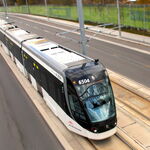The Hydro corridor could be used as a Commuter Rail corridor, so it doesn't matter so much what's around it since it would be more for long distance travel.
I think commuter rail would be overkill. Part of the reason it would work well as a BRT is because:
a) Buses could hop on and off the roadway whenever they want. Think about it, a bus runs local in a neighbourhood, and then runs express to Finch West station via the Hydro Corridor Busway.
b) The BRT can be built incrementally. You start off with a simple roadway with at-grade intersections. No overpasses, no underpasses, no elaborate stations. Bare bones, relatively low capital cost. After a couple years of operation, you determine where the 'problem spots' are. Locations where the at-grade interesections are creating a choke-point for buses (or for cars on the N-S road). Locations where larger stations are needed, etc. You do an overpass here, an underpass there, a new larger station there. None of these upgrades would be a significant capital expenditure, yet incrementally the line would be upgraded to a fully grade-separated busway.
You can't do this with LRT, not without causing significant disruptions to the service. When building a BRT underpass, you re-route the road temporarily 10m further south, build the underpass, and then rip up the temporary road.
EDIT: For those who say the incremental strategy is not a good idea, I will give you the example of the Southwest Transitway extension in Ottawa. When Fallowfield station was built in the late 90s, it was the southwest terminus of the Transitway. It had no rapid transit connection to it at all (seriously, the bus lanes to connect it to the rest of the Transitway wern't even there). It was a bare bones station with a Park N Ride. It wasn't until the mid 2000s that the Southwest Transitway extension was built, which connected it to the rest of the Transitway using a dedicated ROW directly beside Woodroffe through the Greenbelt.
The Transitway has since recently been extended to Barrhaven Town Centre, so the station was rebuilt with a more favourable alignment as a thru-station as opposed to a terminus. The Transitway crosses Fallowfield Rd at-grade en route to Barrhaven Town Centre. The Transitway (and the station) was designed with eventual grade-separation in mind. The station has been placed far enough back from the road to allow for a sufficiently smooth grade change to pass under Fallowfield Rd. In this case, the at-grade configuration is a temporary arrangement until the funds and demand for grade-separation are there. If the line is designed with grade-separation in mind, it can be done relatively smoothly.
Also, they recently did an underpass underneath Strandherd Rd, which caused some minor distruptions, but the road was open nearly the entire time (only closed periodically at night). So the impacts of grade-separation on the road you're separating from can be minimized as well.




